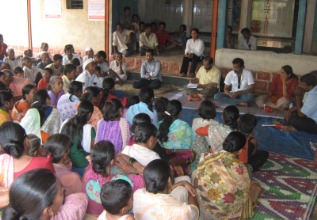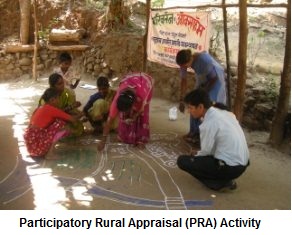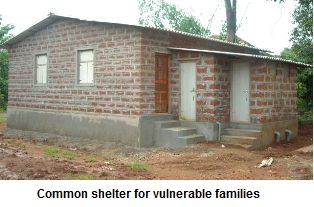Working towards inclusive and sustainable socio-economic
development...
Themes
Techno-Economic Rural Development
Strengthening Citizen Leadership
Disaster Risk Reduction & Mitigation >>
Responce to Climate Change Issues
Themes > Disaster Risk Reduction & Mitigation >
Disaster Risk Reduction & Mitigation >>

Parivartan is working in Ratnagiri district located along the west coast of Maharashtra state which is a part of the Konkan area - a distinct geographical division extending from north to south comprising a narrow strip of land between the Arabian Sea and Western Ghats. The district is prone to natural calamities like heavy rainfall, earthquake, cyclones and other natural disasters.
The hilly area & high rainfall come up as a deadly combination for the communities here in konkan. Chiplun and Khed block stand at high risk during monsoon disasters. The majority of the population here is living in flood prone area. Their houses, agricultural land, livestock are the main risk factors. The usual risks faced by these villages are mountain cracks, land sliding, erosion of soil, loss of cultivating lands, destruction of houses along with means of livelihood & loss of livestock's. The majority of the villages are placed in Koyna Earthquake prone area.
Irreversible damage to crops & sometimes fields has been caused due to the floods & landslides which are the major threats to the farmer community here. Not only the farms but also the inhabited areas are exposed to the disaster.
Our Approach

Response to the disaster in the absence of a defined plan would arbitrarily lead to overemphasis on some actions and lack of other critical actions. Localizing and containing a disaster to the maximum possible extent should be an objective of any disaster plan, so as to minimize its impact on life, environment and property. A formal plan for managing disasters is therefore necessary.
Secondly, the process of bottom up planning is very crucial in case of disaster management. Disaster Risk Reduction plans should be prepared at micro level i.e. hamlet and village levels. Grassroots need to be prepared for risk reduction, rehabilitation and mitigation. This would reduce community dependency on the government or voluntary sector aids. Community awareness on the alarming issues of disasters is inevitable. Self-help approach at grassroots is essential to reduce the impact of natural calamities.
Community Based Disaster Risk Reduction
In July 2005, all the blocks of Ratnagiri district faced problems of heavy rainfall, flood and landslide. Chiplun, Khed, Rajapur and Sangameshwar blocks experienced high frequency of flood and landslide. As an impact, people lost their livelihood resources, houses, agricultural & allied occupational resources. Parivartan had then initiated its activities on this altogether new theme.
Parivartan in partnership with Oxfam Community Aid Abroad have done 'Relief & Rehabilitation' Work at flood affected area in Khed & Chiplun block of Ratnagiri district. The efforts were focused on improving livelihood situation of the community (in large numbers) from amongst the marginalized sections in the region by increasing their access to livelihood resources and improving productivity of their livelihood resources. The activities undertaken were providing fishing nets and reformation of agricultural land as the major victims were fisherfolks and farmers.
147 needy farmers were able to get the reformation of agricultural land done with the help of given assistance which has increased their access to livelihood resource for the proposed season and enhanced the food security for them in the near future. The help has enabled the marginalized sections to make substantial improvements in their livelihood situation which was severely affected due to disaster. For fishing community, livelihood resource were made available wherein the fishing nets were provided to 58 fishing families at individual and group level & boats were made available to 6 women SHGs (102 SHG members).

Keeping in view, the importance of involving the village community and the local governments or Gram Panchayats in the process of planning for disaster preparedness and mitigation at the local level and encourage their participation in the management of disasters and reduction of their impact, Parivartan has taken initiative for preparing the disaster management plans for the fisher community hamlets of 5 villages of its intervention and has also conducted campaigns to build awareness about the disaster management at local level.
The community members were introduced to different phases in disaster management & assimilated the information on Community Based Disaster Management (CBDM) and Participatory Disaster Risk Appraisal (PDRA) tools. The exercise on plan preparation offered them insights for preparing CBDM plan for their village. 5 fisher hamlets prepared hamlet level Community Based Disaster Management Plans.
The workshops & plan preparation process succeeded in giving the necessary insights on disaster management to the community. This was reflected in their pre & post disaster actions. None of the fisher hamlet experienced the loss of nets & boats. Fishermen had shifted their nets & boats to safer places which prevented the heavy losses. Trash houses were partially damaged but didn't registered great amount of household &/or human losses. Hamlet level losses were immediately informed to the village revenue officer.
We also partnered with Oxfam Australia to carry Risk Reduction Program (RRP) where 5 villages were intensively intervened. The activities aimed at developing community based disaster preparedness & risk reduction plans in 5 vulnerable communities to reduce impact of future disasters. Demonstrating model risk mitigation measures identified by the communities and achieving capacity building of multiple stake-holders on effective emergency management at local level in Konkan region were some of the other objectives.

From selected 5 villages Dalvatne- Bagwadi was most vulnerable village. From June 2005 the village was facing the problem of flood. Agricultural land of 25 HHs, 7 houses & Community Center were at risk from flood. People did not have common shelter place to protect themselves from flood. In flood situation Bagwadi used to lose contact with block place. Hence Dalvatne- (Bagwadi) had been selected for model demonstration & construction of Common shelter for vulnerable families and now they are having a common shelter of 40 x 35 ft. area
CBDM Committee, Community Level Volunteers' Committee, CBOs and villagers designed principles for utilization of shelter. The Common Shelter Building has been developed as Village Development Center. Villagers took responsibility of maintenance (electricity, water supply, G.P.tax bill) cost by forming Management Committee.
In order to ensure the availability emergency treatment, first aid kits along with the megaphones were provided to CBDM committees of selected villages. Along with the risk appraisal and capacity building activities, demonstration of structural mitigation (i.e water rescue protection and retaining wall, Desilting of water stream, footbridge and river etc.), distribution of rescue and relief kits, development of IEC material and community insurance are some of the highlighted activities.
The process of structural mitigation (involving Identification of vulnerabilities, finalization of work, actual construction and monitoring) was entirely people participatory. Red-R, Pune provided consulting partnership in the entire structural mitigation process.
Community insurance concept was an innovative activity launched in DRR programme. The objective was to give risk coverage to the CBDM committees and task force team in disaster situations. The booklet on roles of Task Force Group in pre, actual and post disaster has also been published and circulated in all the villages.